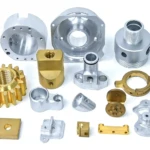The Pioneering Role of Ceramic Additive Manufacturing in Industrial Applications
In the realm of high-performance materials, technical ceramics have long been the gold standard for applications that demand exceptional strength, durability, and reliability. However, the production of ceramic parts can be a challenge, particularly when it comes to maintaining the quality and characteristics of each component. As the industry continues to evolve, companies like Bosch Advanced Ceramics are pushing the boundaries of ceramic additive manufacturing, demonstrating the feasibility and potential of this technology in complex series applications.
The Evolution of Additive Manufacturing
With the advent of additive manufacturing, the production of ceramic parts has entered a new era of innovation and precision. The technology allows for the creation of complex geometries and internal structures that were previously impossible to achieve with traditional manufacturing methods. This has opened up new opportunities for the development of high-performance components for various industries, including medical, semiconductor, energy, automotive, and electronics.
Advantages of Ceramic Additive Manufacturing
The advantages of additive manufacturing over traditional methods are well-documented, but the incorporation of ceramic materials into this process has added an exciting dimension to the game. Some of the key benefits include:
- Complexity and precision: Additive manufacturing allows for the creation of intricate geometries and precise internal structures that were previously unachievable with traditional methods.
- Flexibility and adaptability: Ceramic additive manufacturing enables the quick adaptation of design and process parameters, making it an ideal solution for evolving design and production requirements.
- Cost savings: Elimination of expensive molds and reduced material waste contribute to significant cost savings.
- Increased production capacity: Ceramic 3D printing allows for the production of multiple parts in a single printing process, significantly increasing overall production capacity.
Bosch Advanced Ceramics and the Ceramic Additive Manufacturing Revolution
Bosch Advanced Ceramics, a subsidiary of the renowned Bosch group, has been at the forefront of the ceramic additive manufacturing revolution. Founded in 2014, the company has been instrumental in bridging the gap between prototyping and large-scale industrial production. With a focus on innovative ceramic additive manufacturing, Bosch Advanced Ceramics is empowering industries to create complex parts with unparalleled precision and quality.
Use Cases: Real-World Applications of Ceramic Additive Manufacturing
The versatility of ceramic additive manufacturing has been demonstrated through various use cases across different industries, highlighting its potential for a wide range of applications.
High-temperature Resistant Thermal Device Parts
In the energy sector, Bosch Advanced Ceramics has developed thermal device parts for high-temperature applications, emphasizing the material’s high thermal resistance and wear resistance.
Insulated Sleeves for Medical Instruments
In the medical sector, ceramic additive manufacturing is used to produce very small, complex insulated sleeves for laparoscopic instruments. These sleeves have a minimum external diameter of 1.3 mm and wall thickness of only 90 microns, a challenge for traditional manufacturing methods.
Injection needles for the Pharmaceutical Industry
The demand for more complex structures in the medical industry is such that ceramic additive manufacturing is now an ideal choice for this application thanks to its fine-printing capacities and electrical insulation.
Additive Manufactured Electronic Component for the Electronics Industry
The high precision of the ceramic additive manufacturing process allows the smallest details to be produced with extremely low roughness while achieving dimensions with the precision required by the electronics industry.
Conclusion
Ceramic additive manufacturing has the potential to revolutionize the field of high-performance materials, offering unparalleled precision and complexity in the production of ceramic parts. Companies like Bosch Advanced Ceramics are leading the charge, pushing the boundaries of what is possible in the field of ceramic additive manufacturing.
Innovative technologies can be found in.
The possibilities offered by this technology will undoubtedly push forward not only the development of ceramic products but also the various fields of application in which these materials can be used.
With the support of experts who can cover the entire design chain, from design to production that series of innovations in the industry have given companies that work with these people a significant competitive advantage.

















